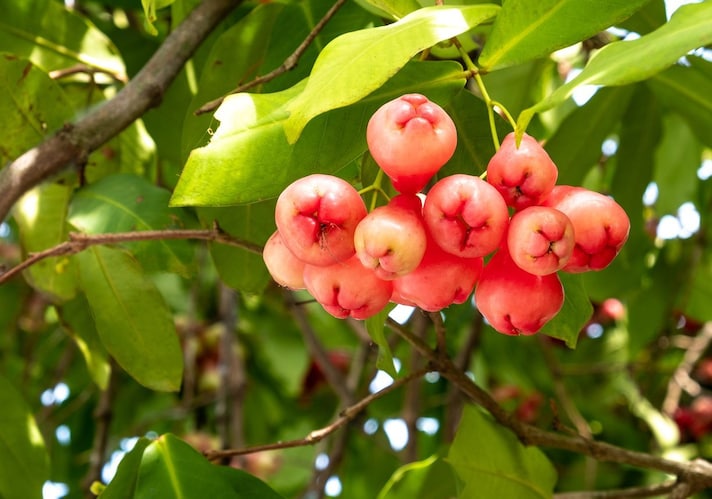
Its shape resembles that of a bell, its color that of an apple and its consistency that of a watermelon: we are talking about the water apple, a little-known tropical fruit that is unfortunately difficult to find in the U.S.. It grows in subtropical areas, is low in calories and has a huge amount of benefits.
What Are Water Apples and Where Do They Come From?
Water apples – also known in English bellfruit or water cherry or even jambu in Malaysia – are the fruits of the Syzygium aqueum plant, typical of subtropical climates: in fact, this plant is grown in areas ranging from Malaysia to Queensland, in Australia, passing through India and Thailand.
At first glance they might seem like just some bizarrely shaped apples: in reality, unlike what their name might suggest, their flavor, sweet and slightly acidic, actually resembles that of an apple; but if we look at their consistency, it takes on the appearance of a watermelon, being particularly juicy, crunchy and watery; as for their aroma, however, it is very reminiscent of a rose – and it is no coincidence that this fruit is also called the pink apple.

As for the water apple plant, it is particularly faithful to the saying “in the kitchen nothing is thrown away”: in fact, not only the fruit is used, but all the parts can acquire a second life. The wood, for example, being particularly robust, is usually used in the construction of tools, while the bark is used in herbal medicine and, finally, the leaves are edible and are often used to wrap food.
A Tropical Fruit With Great Beneficial Properties
A fruit that has the word “water” in its name does not leave much room for free interpretation: in fact, water apples are made up of 90% water, which makes them particularly suitable for being consumed in a low-calorie diet. But not only that: they are rich in dietary fiber that aids digestion and contributing to better cardiac function. They are also rich in vitamins A, B and C which help, respectively, to improve eyesight, regulate metabolism and strengthen the immune system. They are also a valid ally in preventing damage from free radicals, thanks to the presence of iron, calcium and antioxidants. And last but not least, their leaves are rich in flavonoids that offer anti-inflammatory properties to those suffering from chronic diseases.

Where to Find Them and How to Consume Them
If you are in any country in South-East Asia you can be sure that you will find these fruits on most fruit stands. Unfortunately, however, as already mentioned, it is not at all easy to find water apples in our country: it is easier to find the plant on the market that, with a little attention and care, can be grown in the hottest and most humid areas of the continent.
But how can they be used in the kitchen? In addition to being consumed, obviously, as a normal fruit, they can be used to make smoothies, jams and fresh juices. Their consistency also makes them particularly suitable to be added in cubes to a nice summer salad or even chopped to prepare a delicious chutney.
;Resize,width=767;)
